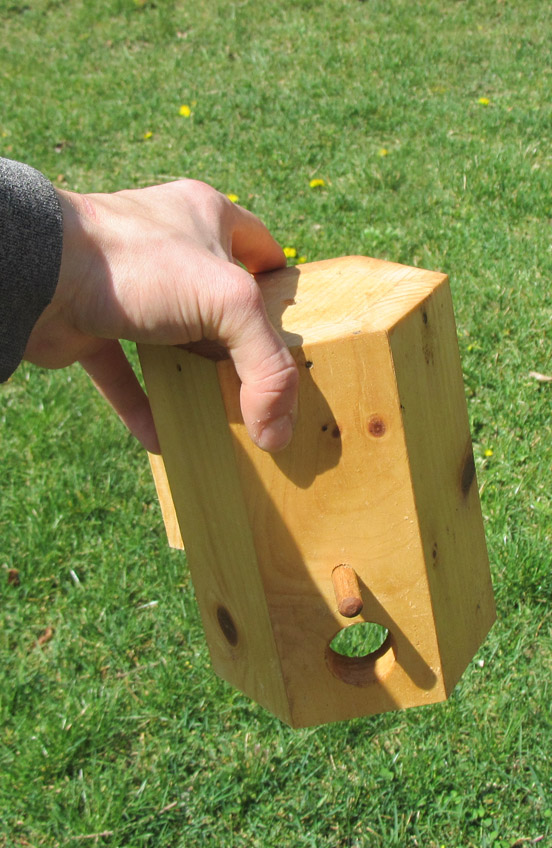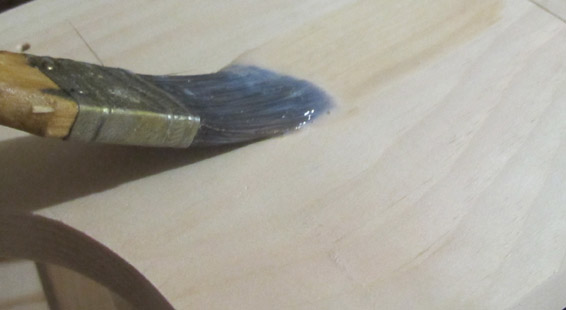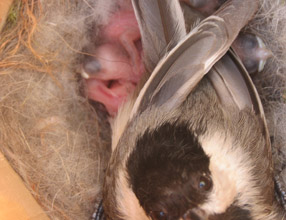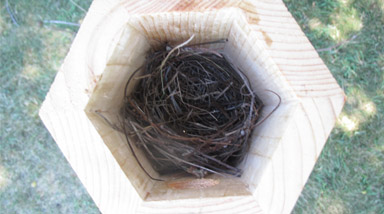Scientific Name |
Common Name |
Diet |
Clutch Size & ID |
Incubation Period
|
Nestling Period
|
| Aegolius acadicus |
Saw Whet Owl |
small mammals |
5 - 6 white eggs |
26 - 29 days |
27 - 34 days |
| Aix sponsa |
Wood Duck |
seeds, insects, arthropods |
5 - 15 white eggs |
28 - 37 days |
56 - 70 days |
| Baeolophus bicolor |
Tuffed Titmouse |
seeds, insects |
5 - 6 white, brown dotted eggs |
12 - 14 days |
15 - 16 days |
| Bucephala albeola |
Bufflehead Duck |
insects, fish, eggs, aquatic plants |
6 - 11 white eggs |
28 - 32 days |
50 - 55 days |
| Bucephala islandica |
Barrow's Goldeneye Duck |
insects, fish, eggs, aquatic plants |
4 - 12 greenish white eggs |
28 - 32 days |
24 - 36 hours |
| Carpodacus mexicanus |
House Finch |
seeds, berries |
4- 5 greenish-white, black spotted eggs |
12 - 14 days |
11 - 19 days |
| Certhia americana |
Brown Creeper |
insects, seeds, arthropods |
5 - 6 white, brown spotted eggs |
12 - 14 days |
14 - 20 days |
| Colaptes auratus |
Northern Flicker |
insects |
6 - 8 white eggs |
11 - 14 days |
24 - 27 days |
| Dryocopus pileatus |
Pileated Woodpecker |
insects, berries, seeds |
3 - 5 white eggs |
14 - 18 days |
24 - 28 days |
| Falco tinnunculus |
Kestrel |
insects, small mammals |
4 - 5 pale brown, brown dotted eggs |
26 - 31 days |
28 - 31 days |
| Glaucidium brasilianum |
Pygmy Owl |
small mammals, amhibians, insects |
3 - 5 white eggs |
28 - 29 days |
28 - 30 days |
| Hirundo rustica |
Swallow |
insects |
6 - 8 white eggs |
26 - 30 days |
28 - 31 days |
| Megascops kennicottii |
Screech Owl |
insects, small mammals, birds, amphibians |
3 - 4 white eggs |
26 - 30 days |
28 - 31 days |
| Melanerpes carolinus |
Red-Bellied Woodpecker |
insects, fuit, seeds |
4 - 5 white eggs |
11 - 14 days |
24 - 27 days |
| Melanerpes erythroceph |
Red-Headed Woodpecker |
insects, earthworms, seeds, berries |
4 - 7 white eggs |
12 - 14 days |
24 - 31 days |
| Melanerpes lewis |
Lewis Woodpecker |
insects |
5 - 9 white eggs |
13 - 14 days |
24 -31 days |
| Myiarchus crinitus |
Crested Flycatcher |
insects, berries, fruit |
4 - 8 white, brown spotted eggs |
13 - 15 days |
13 - 15 days |
| Passer domesticus |
Sparrow |
seeds, berries, insects |
3 - 5 white-bluish-green, brown spotted eggs |
11 - 14 days |
12 - 14 days |
| Picoides pubescens |
Downy Woodpecker |
insects, berries, seeds |
4 - 5 white eggs |
11 - 12 days |
18 - 21 days |
| Picoides villosus |
Hairy Woodpecker |
insects |
3 - 6 white eggs |
11 - 12 days |
28 - 30 days |
| Plectrophenax nivalis |
Snow Bunding |
insects |
4 - 6 white, redish-brown spotted eggs |
10 - 16 days |
10 - 17 days |
| Poecile atricapillus |
Black-capped Chickadee |
insects, seeds, berries |
6 - 8 white, brown spotted eggs |
12 - 14 days |
12 - 16 days |
| Poecile cinctus |
Siberian Chickadee |
insects, seeds, berries |
6 - 10 white, brown spotted eggs |
15 - 18 days |
12 - 16 days |
| Poecile gambeli |
Mountain Chickadee |
insects, seeds berries |
6 -12 white eggs |
12 - 15 days |
17 - 23 days |
| Poecile rufescens |
Chestnut-backed Chickadee |
insects, seeds berries |
5 - 8 white eggs |
12 - 18 days |
18 - 21 days |
| Progne subis |
Purple Martin |
insects |
3 - 6 white eggs |
15 - 18 days |
27 - 34 days |
| Protonotaria citrea |
Prothonotary Warbler |
insects, seeds, berries |
4 - 6 white to yellow eggs |
12 - 14 days |
11 - 14 days |
| Quiscalus quiscula |
Grackle |
seeds, insects, arthropods |
2 - 6 brown spotted eggs |
12 - 14 days |
20 - 23 days |
| Sialia currucoides |
Mountain Bluebird |
insects, berries |
3 - 8 light blue eggs |
12 - 14 days |
18 - 21 days |
| Sialia mexicana |
Western Bluebird |
insects, berries, seeds |
2 - 8 light blue eggs |
12 - 14 days |
18 - 22 days |
| Sialia sialia |
Eastern Bluebird |
insects, berries, seeds |
3 - 7 light blue eggs |
12 - 14 days |
17 - 21 days |
| Sitta canadensis |
Red Breasted Nuthatch |
insects, arthropods |
5 - 8 white, brown spotted eggs |
12 - 13 days |
18 - 21 days |
| Sitta carolinensis |
White Breasted Nuthatch |
insects, seeds, berries |
5 - 6 white, brown spotted eggs |
13 - 14 days |
24 - 27 days |
| Sitta pusilla |
Brown Headed Nuthatch |
insects, seeds, berries |
6 - 8 white, brown spotted eggs |
13 - 14 days |
18 - 20 days |
| Sitta pygmaea |
Pygmy Nuthatch |
insects, seeds |
5 - 9 white, red spotted eggs |
14 - 17 days |
14 - 22 days |
| Sphyrapicus varius |
Sapsucker Woodpecker |
insects, berries |
5 - 7 white eggs |
12 - 13 days |
25 - 30 days |
| Thryomanes bewickii |
Bewick's Wren |
insects |
4 - 7 white, brown spotted eggs |
12 - 14 days |
14 - 16 days |
| Troglodytes aedon |
House Wren |
insects |
4 - 8 white, brown spotted eggs |
12 - 14 days |
14 - 16 days |
| Troglodytes hiemalis |
Winter Wren |
insects |
3 - 8 light speckled eggs |
14 - 16 days |
16 - 17 days |
| Troglodytes ludovicianus |
Carolina Wren |
insects |
4 - 6 white, brown spotted eggs |
12 - 14 days |
12 - 16 days |
| Tyto alba |
Barn Owl |
small mammals, birds |
5 - 6 white eggs |
29 - 24 days |
50 - 55 days |
Cleaning Out Old Nests
|
 | | Cleaning out an old nest from a birdhouse |
|
Many birdhouses have no way of being opened and should be assumed to be made for decorative purposes. While these ornamental birdhouses may be nice to look at, they do not provide the features that are essential for the welfare of the birds. As mentioned above, the top priority when it comes to birdhouse maintenance is cleaning out the nest immediately after the birds have fledged.
By cleaning the birdhouse as soon as the birds have fledged, you are more likely to keep moisture levels low, and lower the chance that pests and nest parasites will inhabit the birdhouse. With regards to wrens and bluebirds, if the nest is cleaned out immediately after the birds have fledged, it is possible to get a second and even a third set of birds in the same birdhouse in a single season!
When removing old nests from your birdhouse ensure that the drainage holes are clear. Removing debris with a small twig might make a big difference for the next family of birds moving into your birdhouse. Many people wait to clean out their birdhouse in the fall, but if it is cleaned regularly birds can be removing insect pests from your yard throughout most of the growing season.
If the next box interior is soiled, a mild bleach solution can be used to help remove any parasites or pathogens from the birdhouse body. Be sure to allow the birdhouse to dry before re-mounting. Ensure all hardware is still firmly in place (if any) before remounting.
|
Re-coating with a Non-toxic Preservative
|
After four or more years a birdhouse can be recoated with an environmentally friendly preservative that is non-toxic for the birds. We recommend using PolyWhey due to it is extremely low VOC level when applied as well as the durable waterproof coating it provides. More information can be found on the Staining, Painting or Preserving section.
If built properly, a birdhouse can last over a decade. The hexagonal birdhouse in the picture to the right was taken in 2013, 19 years after it was mounted on our barn.
|
 |
| Using a paint brush to apply PolyWhey coating |
|












